For the 2025 school year, there is 1 public preschool serving 366 students in Dekalb Independent School District. This district's average pre testing ranking is 9/10, which is in the top 20% of public pre schools in Texas.
Public Preschool in Dekalb Independent School District have an average math proficiency score of 57% (versus the Texas public pre school average of 43%), and reading proficiency score of 62% (versus the 53% statewide average).
Minority enrollment is 35% of the student body (majority Black), which is less than the Texas public preschool average of 76% (majority Hispanic).
Overview
This School District
This State (TX)
# Schools
3 Schools
4,192 Schools
# Students
901 Students
2,151,418 Students
# Teachers
76 Teachers
147,942 Teachers
Student : Teacher Ratio
12:1
12:1
District Rank
Dekalb Independent School District, which is ranked #606 of all 1,196 school districts in Texas (based off of combined math and reading proficiency testing data) for the 2021-2022 school year.
The school district's graduation rate of 90% has stayed relatively flat over five school years.
Overall District Rank
#621 out of 1204 school districts
(Bottom 50%)
(Bottom 50%)
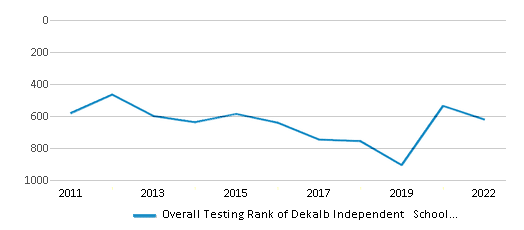
Math Test Scores (% Proficient)
46%
41%
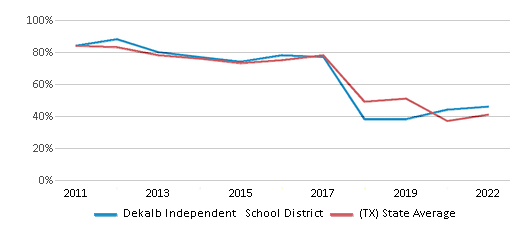
Reading/Language Arts Test Scores (% Proficient)
44%
51%
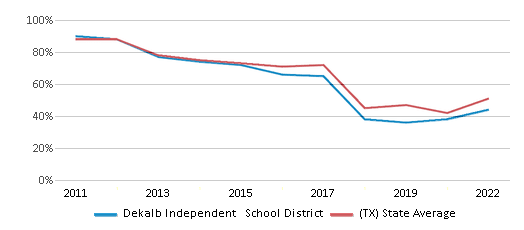
Science Test Scores (% Proficient)
43%
46%

Graduation Rate
≥90%
90%

Students by Ethnicity:
Diversity Score
0.56
0.63
# American Indian Students
6 Students
6,302 Students
% American Indian Students
1%
n/a
# Asian Students
4 Students
104,203 Students
% Asian Students
n/a
5%
# Hispanic Students
121 Students
1,180,208 Students
% Hispanic Students
13%
55%
# Black Students
132 Students
275,255 Students
% Black Students
15%
13%
# White Students
574 Students
509,082 Students
% White Students
64%
24%
# Hawaiian Students
n/a
3,291 Students
% Hawaiian Students
n/a
n/a
# Two or more races Students
64 Students
73,077 Students
% of Two or more races Students
7%
3%
Students by Grade:
# Students in PK Grade:
91
275,832
# Students in K Grade:
56
307,607
# Students in 1st Grade:
50
310,480
# Students in 2nd Grade:
58
317,113
# Students in 3rd Grade:
56
300,451
# Students in 4th Grade:
55
295,281
# Students in 5th Grade:
49
258,890
# Students in 6th Grade:
68
33,806
# Students in 7th Grade:
80
14,241
# Students in 8th Grade:
60
12,959
# Students in 9th Grade:
76
7,002
# Students in 10th Grade:
76
6,366
# Students in 11th Grade:
71
5,781
# Students in 12th Grade:
55
5,609
# Ungraded Students:
-
-
District Revenue and Spending
The revenue/student of $12,937 in this school district is less than the state median of $13,387. The school district revenue/student has declined by 15% over four school years.
The school district's spending/student of $10,698 is less than the state median of $14,116. The school district spending/student has declined by 15% over four school years.
Total Revenue
$12 MM
$74,029 MM
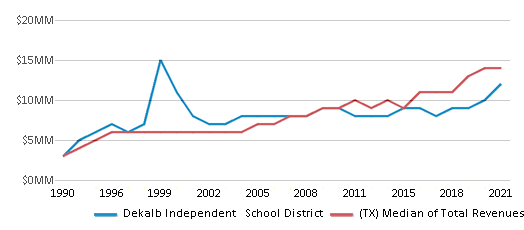
Spending
$10 MM
$78,063 MM
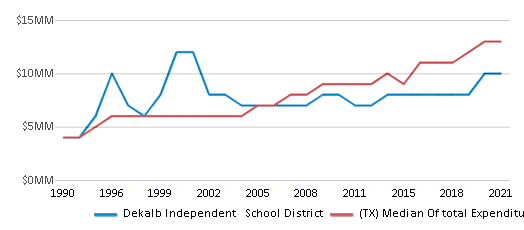
Revenue / Student
$12,937
$13,387
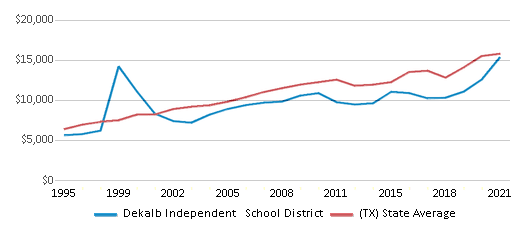
Spending / Student
$10,698
$14,116

Best Dekalb Independent School District Public Preschools (2025)
School
(Math and Reading Proficiency)
(Math and Reading Proficiency)
Location
Grades
Students
Rank: #11.
Dekalb Elementary School
(Math: 55-59% | Reading: 60-64%)
Rank:
Rank:
9/
Top 20%10
101 W Fannin St
De Kalb, TX 75559
(903) 667-2328
De Kalb, TX 75559
(903) 667-2328
Grades: PK-4
| 366 students
Recent Articles

Teaching: Contract Renewal
We offer a guide for teachers facing contract renewal, offering practical advice on demonstrating value, maintaining professional relationships, and ensuring successful contract renewal in public schools.

What Is A Charter School?
Explore the world of charter schools in this comprehensive guide. Learn about their history, how they operate, and the pros and cons of this educational innovation. Discover key facts about charter schools, including admission policies, demographics, and funding, as well as what to look for when considering a charter school for your child.

February 05, 2025
Understanding the U.S. Department of Education: Structure, Impact, and EvolutionWe explore how the Department of Education shapes American education, from its cabinet-level leadership to its impact on millions of students, written for general audiences seeking clarity on this vital institution.





